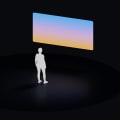Grid systems are an essential tool for any web designer looking to create visually appealing and functional websites. These systems provide a framework for organizing and arranging content on a webpage, making it easier for users to navigate and find the information they need. In this article, we will take a comprehensive look at grid systems for web design and how they can improve the overall user experience. Whether you are new to web design or looking to brush up on your skills, this article will provide valuable insights into the world of grid systems and how they can elevate your UI design.
So, let's dive in and explore the ins and outs of grid systems for web design!Grid systems are a fundamental aspect of web design, providing a framework for organizing elements on a page. They consist of vertical and horizontal lines that divide the page into columns and rows, creating a grid-like structure. This structure helps designers to maintain consistency, balance, and hierarchy in their designs. To better understand the importance of grid systems, let's explore some key points.
Consistency:
One of the main benefits of using a grid system is that it helps maintain consistency in your design.By dividing your page into columns and rows, you can ensure that elements are aligned and spaced evenly throughout the design. This creates a cohesive and professional look that is pleasing to the eye.
Balance:
Grid systems also play a crucial role in achieving balance in your design. By following the grid structure, you can create a visual balance between different elements on the page. This prevents your design from looking cluttered or unbalanced, which can be distracting to users.Hierarchy:
Another advantage of using grid systems is that they help establish a hierarchy in your design.By utilizing different grid sizes and spacing, you can draw attention to specific elements on the page and guide the user's eye to important information. This makes for a more intuitive and user-friendly design. Furthermore, grid systems offer flexibility and scalability to your designs. Whether you are designing for desktop or mobile devices, grids can easily adapt to different screen sizes, ensuring your design remains consistent and functional across all platforms.
So how do you use grid systems in your web design?
The first step is to choose a grid system that best suits your needs. There are various types of grid systems available, such as fixed, fluid, and responsive grids.Each has its advantages and can be used for different design styles. Next, you need to determine the number of columns and the column width for your grid. This will depend on the content and layout of your website. Generally, a grid with 12 columns and a maximum width of 960px is a popular choice among designers. Once you have your grid set up, it's essential to stick to it throughout your design. Use the grid as a guide when placing elements on the page, ensuring they align with the columns and rows.
You can also play with the spacing and size of elements to create an aesthetically pleasing design while still adhering to the grid structure. Finally, don't be afraid to break the grid when necessary. While grids provide structure and organization, they should not limit your creativity. Breaking the grid can add visual interest and create a unique design that stands out from the rest. In conclusion, grid systems are an essential tool in web design. They offer consistency, balance, hierarchy, flexibility, and scalability to your designs.
By using grids, you can create visually appealing and functional designs that enhance the user experience. So why not incorporate grid systems into your next web design project?
The Benefits of Using Grid Systems
Welcome to our guide on grid systems for web design. In this article, we will cover everything you need to know about using grid systems to improve your user interface design. Whether you are a beginner or an experienced designer, you will find valuable tips, techniques, and resources to help you create a user-centered design that is visually appealing and functional.So let's dive in! Grid systems offer several benefits for web designers, including:
- Improved visual hierarchy: By using a grid system, designers can create a clear and consistent layout that guides the user's eye to important elements on the page.
- Better organization: Grid systems help designers to organize content in a logical and structured manner, making it easier for users to navigate and find what they are looking for.
- Efficient use of space: With a grid system, designers can make the most out of the available space on a webpage, ensuring that the design is balanced and visually appealing.


